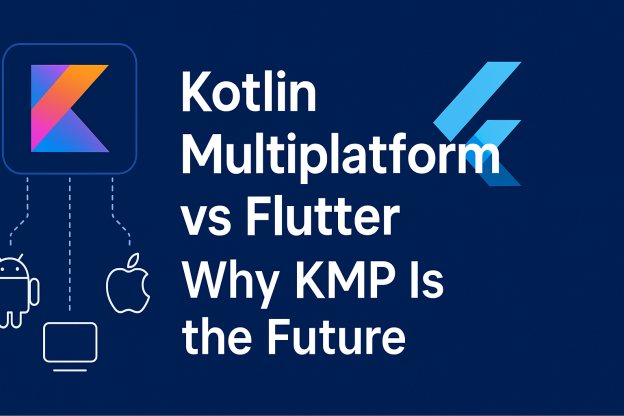The Rise of Kotlin Multiplatform: Is It the Next Big Thing?

The landscape of mobile app development is changing rapidly with new technologies coming into the market. Earlier, mobile app development was platform-specific. It means developers were expected to learn the native languages to code. But with cross-platform app development technologies like Flutter, developers can make apps with responsive UIs and a native-like interface. However, to integrate UI with the existing native interface and provide a truly native look to an app, developers prefer Kotlin multiplatform (KMP).
How do developers determine which platform best meets their mobile app requirements? In this article, we will discover why Kotlin Multiplatform is becoming a go-to choice for many developers over technologies like Flutter.
What is Kotlin Multiplatform?
Kotlin Multiplatform (KMP) allows seamless code sharing and native UI development for developers. It’s an open-source technology developed by JetBrains that enables developers to share Kotlin code across platforms. It means that developers can create a shared module which will be used to develop apps for Android and iOS.
If you ever feel coding for different platforms is a hassle, Kotlin multiplatform allows you to write common data models, business logic and network layers. Developers can use this code across Windows, Linux, iOS and Android applications. You don’t have to worry about the UI of the mobile app. A separate design team can work on the front-end of the application while you maintain its logic and data models. Developers write code in Kotlin and compile it to various targets.
(Source: JetBrains)
Benefits of Using Kotlin Multiplatform
Code Sharing and Reusability
Kotlin Multiplatform eliminates the redundancy of code development. Developers can write the business logic once and use it across various platforms. Kotlin Multiplatform is effective as it allows sharing code, which is among its many benefits. Developers can save time in development, which helps make the entire coding process more efficient and increases code reusability.
Fully Native Experience for Users
App development using a shared code allows developers to create a custom UI for different platforms. The KMP platform is designed in a way that allows a complete native experience for users. It enables code sharing while also allowing developers to implement platform-specific UI.
Custom UI for Each Platform
Dveelopers can create custom UI for each platform. For example, the look and feel of an Android app interface can be different from the one created for an iOS app. The underlying business rules, data models and networking will be the same across different OS. KMP allows designers to tailor the user interactions according to the platform-specific requirements and user expectations.
Kotlin Multiplatform eases a developer’s dilemma of having to choose between native and cross-platform development. Developers can choose what to write and share natively. Before KMP, developers had to write everything in a native platform-specific language.
Performance Optimisation and Comparison with Flutter
Unlike technologies like Flutter, which have their own rendering engine, there is no need for an independent rendering engine in Kotlin Multiplatform. KMP relies on the existing rendering capacity of the platform and hence, the app size is optimised. Unlike Flutter, KMP has a 100% native interface, which offers optimised app performance.
Why Companies are Choosing Kotlin Multiplatform over Cross-App Development?
Companies like Netflix, Phillips, VMware, and McDonald’s have already adopted Kotlin Multiplatform for native app performance. The technology does not feel like an overpromise because it delivers correctly.
Kotlin Multiplatform brings a paradigm shift in the industry with less duplicated code, native performance and better aligned teams. The web, iOS, and Android developers work together to build the same logical foundation for the app. Mobile App development using Kotlin multiplatform is based on a single source of business logic. In addition to that, there is no dependency of code on the rendering engines, which is not the case with cross-platform app development.
Why Choose Kotlin Multiplatform Over Flutter?
The primary difference between Flutter and Kotlin Multiplatform is in Architecture, App size and Performance.
- Coming to architecture, you will find that business logic and UI are coupled tightly in the Dart ecosystem of Flutter. On the other hand, developers can keep the business logic separate from UI in KMP.
- Due to having separate business logic and UI, Kotlin Multiplatform allows for 100% native interface development.
- Kotlin Multiplatform does not need a rendering engine because it can work well with native UI, which is not the case with Flutter. Flutter needs its rendering engine, which affects the app’s performance. The rendering engine adds a new layer between the Flutter code and the UI.
- Flutter-based apps are heavier in size as compared to optimised apps developed in Kotlin Multiplatform.
To Sum Up
KMP has a 100% native interface as opposed to the native-like interface of Flutter. Kotlin Multiplatform have advanced compilers through which developers can streamline the code and achieve cross-platform compatibility. Without heavy rendering engines to support the native interface, apps developed on Kotlin Multiplatform have optimised performance. However, it is not a comprehensive cross-platform solution; it facilitates code reuse. You can leverage our mobile app development services at VerveLogic, a leading mobile app development company in California. Our developers provide seamless support in meeting your mobile app development needs.





